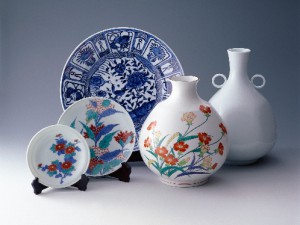Arita Ware: Characteristics
Arita Ware, which has a long history, is generally divided into three styles: Old Imari, Kakiemon and Nabeshima.

Old Imari is a term referring to Hizen ceramic goods which were the first examples of Arita Ware made in the Edo Era. They were named as Old Imari due to the fact that they were shipped out of Imari Port. When saying “Old Imari Style”, the meaning refers to the painting style known as “Kinrande” or Kinran type. Kinrande refers to a valuable fabric, known as “kinran”, which has gold thread embroidered into it; the painting style resembles this style. The underglazing is dark while colors of red and gold are lavishly used to create a style in which objects such as flowers are drawn all over the surface. It is thought that in the economically affluent Genroku Era, traits of this were reflected. Old Imari is a style that first appeared in the Genroku period (1688-1704) of the Edo Era, to be handed over to the present day and is very representative of Arita Ware.
Works done in the Kakiemon style were exported to Europe during the Edo Era, and had a great influence on European ceramics and porcelain, which included starting the Meissen kilns of Germany, and gained great appreciation. On its milky-white canvas, sophisticated designs were painted while leaving a lot of white space; the material was often compared to the whitish water left after washing rice, known in the Arita dialect as nigoshi. The style of Japanese paintings, coupled with the nigoshide style of milky-white color left a distinctive beauty and greatly influenced European ceramics and porcelain goods. This traditional method was designated as Japan’s Important Intangible Cultural Asset, although goods made in the Kakiemon style ceased to be made due to Kinrande which flourished during the Genroku Era. However in 1953, the 12th and 13th Sakaida Kakiemon brought back the style and it continues to the present day.
The Nabeshima style was developed in the official kilns of the Nabeshima clan in Saga Prefecture for special gifts and for personal use. Labeled as “Nabeshima”, the style gained great prestige globally. The official kilns were thought to be established during the Kan’ei Era (1624-1644) in Arita’s Iwataniuchi district and were moved to Minami-Kawahara during the Kanbun Era (1661-1673), before making their final move to Okawauchi in Imari during the En’po Era (1673-1680). In Nabeshima, there was celadon ceramics and dyeing; these were accompanied by the works known as Iro Nabeshima which also contained paintings within their interior. Ornamenting Iro Nabeshima were blue dyeing, and paintings of red, green and yellow to make up the four basic colors. The patterns of bluish tinge on the surface were overflowing with nobility and dignity, and the techniques were passed on via the Iro Nabeshima Technique Preservation Society. The society was designated as the nation’s Important Intangible Cultural Asset. The household of Imaemon Imaizumi of the akae town was requested to design the goods fired from the Nabeshima clan kilns in Okawauchi during the latter half of the Edo Era. Because of this, contemporary Arita has kept continuing this style.
Arita Ware, over its 400-year-long history, has amassed everything from daily goods to works of art to be appreciated, and continues to fascinate admirers with its beautiful white surface, vivid coloration, its utility and durability.
>> History
>> Potter
>> Photos
Article and photos by Arita town
